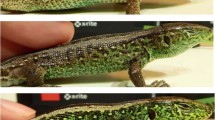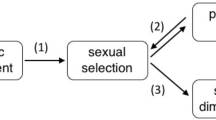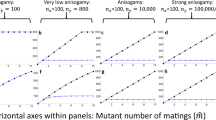Abstract
Indirect-benefit models of sexual selection assert that females gain heritable offspring advantages through a mating bias for males of superior genetic quality. This has generally been tested by associating a simple morphological quality indicator (for example, bird tail length) with offspring viability1. However, selection acts simultaneously on many characters, limiting the ability to detect significant associations, especially if the simple indicator is weakly correlated to male fitness2,3. Furthermore, recent conceptual developments suggest that the benefits gained from such mating biases may be sex-specific because of sexually antagonistic genes that differentially influence male and female reproductive ability4. A more suitable test of the indirect-benefit model would examine associations between an aggregate quality indicator1,3 (such as male mating success) and gender-specific adult fitness components, under the expectation that these components may trade off1. Here, we show that a father's mating success in the cricket, Allonemobius socius, is positively genetically correlated with his son's mating success but negatively with his daughter's reproductive success. This provides empirical evidence that a female mating bias can result in sexually antagonistic offspring fitness.
This is a preview of subscription content, access via your institution
Access options
Subscribe to this journal
Receive 51 print issues and online access
$199.00 per year
only $3.90 per issue
Buy this article
- Purchase on Springer Link
- Instant access to full article PDF
Prices may be subject to local taxes which are calculated during checkout

Similar content being viewed by others
References
Kokko, H. Fisherian and ‘good genes’ benefits of mate choice: how (not) to distinguish between them. Ecol. Lett. 4, 322–326 (2001)
Boake, C. R. B. Genetic consequences of mate choice: a quantitative genetic method for testing sexual selection theory. Science 227, 1061–1063 (1985)
Heisler, I. L. Quantitative genetic models of female choice based on “arbitrary” male characters. Heredity 55, 187–198 (1985)
Chippindale, A. K., Gibson, J. R. & Rice, W. R. Negative genetic correlation for adult fitness between sexes reveals ontogenetic conflict in Drosophila. Proc. Natl Acad. Sci. USA 98, 1671–1675 (2001)
Rice, W. R. Dangerous liaisons. Proc. Natl Acad. Sci. USA 97, 12953–12955 (2000)
Chapman, T., Arnqvist, G., Bangham, J. & Rowe, L. Sexual conflict. Trends Ecol. Evol. 18, 41–47 (2003)
Fedorka, K. M. & Mousseau, T. A. Tibial spur feeding in ground crickets: larger males contribute larger gifts (Orthoptera: Gryllidae). Florida Entomol. 85, 317–323 (2002)
Fedorka, K. M. & Mousseau, T. A. Nuptial gifts and the evolution of male body size. Evolution 56, 590–596 (2002)
Wedell, N. & Tregenza, T. Successful fathers sire successful sons. Evolution 53, 620–625 (1999)
Mousseau, T. A. & Dingle, H. Maternal effects in insect life histories. Annu. Rev. Entomol. 36, 511–534 (1991)
Mousseau, T. A. & Dingle, H. in The Unity of Evolutionary Biology (ed. Dudley, E. C.) 745–761 (Dioscorides, Portland, Oregon, 1991)
Roff, D. A. Evolutionary Quantitative Genetics (Chapman & Hall, New York, 1997)
Montalvo, A. M. & Shaw, R. G. Quantitative genetics of sequential life history and juvenile traits in the partially selfing perennial, Aquilegia caerulea. Evolution 48, 828–841 (1994)
Zar, J. H. Biostatistical Analysis 2nd edn, 324 (Prentice Hall, Englewood Cliffs, New Jersey, 1984)
Lynch, M. & Walsh, B. Genetics and Analysis of Quantitative Traits 632–637 (Sinauer Associates, Sunderland, 1998)
Acknowledgements
We thank D. Promislow, P. Mack and J. Burger for comments on previous manuscript versions. We also thank N. Leung and A. Penn for assisting with cricket maintenance and data collection. This work was supported by a NSF Doctoral Dissertation Improvement Grant to K.M.F. and a NSF grant to T.A.M.
Author information
Authors and Affiliations
Corresponding author
Ethics declarations
Competing interests
The authors declare that they have no competing financial interests.
Rights and permissions
About this article
Cite this article
Fedorka, K., Mousseau, T. Female mating bias results in conflicting sex-specific offspring fitness. Nature 429, 65–67 (2004). https://doi.org/10.1038/nature02492
Received:
Accepted:
Issue Date:
DOI: https://doi.org/10.1038/nature02492
This article is cited by
-
Mating with sexually attractive males provides female Gryllus firmus field crickets with direct but not indirect fitness benefits
Behavioral Ecology and Sociobiology (2020)
-
Transgenerational effects of maternal sexual interactions in seed beetles
Heredity (2018)
-
Life-history consequences of bidirectional selection for male morph in a male-dimorphic bulb mite
Experimental and Applied Acarology (2018)
-
Male-benefit sexually antagonistic genotypes show elevated vulnerability to inbreeding
BMC Evolutionary Biology (2017)
-
Sexual conflict maintains variation at an insecticide resistance locus
BMC Biology (2015)
Comments
By submitting a comment you agree to abide by our Terms and Community Guidelines. If you find something abusive or that does not comply with our terms or guidelines please flag it as inappropriate.



